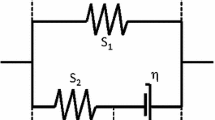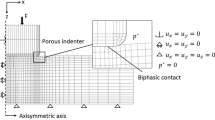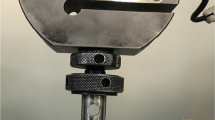Abstract
Recent imaging has revealed that in vivo contact deformations of human knee cartilage under physiological loadings are surprisingly large—typically on the order of 10%, but up to 20 or 30% of tibiofemora cartilage thickness depending on loading conditions. In this paper we develop a biphasic, large deformation, non-linear poroelastic model of cartilage that can accurately represent the time dependence and magnitude of cyclic cartilage deformations in vivo. The model takes into account cartilage tension–compression nonlinearity and a new constitutive relation in which the compressive stiffness and hydraulic permeability of the cartilage adjusts in response to the strain-dependent aggrecan concentration. The model predictions are validated using experimental test results on osteochondral plugs obtained from human cadavers. We find that model parameters can be optimised to give an excellent fit to the experimental data. Using typical hydraulic conductivity and stiffness parameters for healthy cartilage, we find that the experimentally observed transient and steady state tissue deformations under cyclic loading and unloading can be reproduced by the model. Steady state tissue deformations are shown to cycle between 10% (exudation strain) and 20% (total strain) in response to the cyclic test loads. At steady-state cyclic loading, the pore fluid exuded from the tissue is exactly equal to the pore fluid imbibed by the tissue during each load cycle.








Similar content being viewed by others
References
Ateshian, G. A., N. O. Chahine, I. M. Basalo, and C. T. Hung. The correspondence between equilibrium biphasic and triphasic material properties in mixture models of articular cartilage. J. Biomech. 37:391–400, 2004.
Bachrach, N. M., W. B. Valhmu, E. Stazzone, A. Ratcliffe, W. M. Lai, and V. C. Mow. Changes in proteoglycan synthesis of chondrocytes in articular cartilage are associated with the time-dependent changes in their mechanical environment. J. Biomech. 28:1561–1569, 1995.
Barker, M. K., and B. B. Seedhom. The relationship of the compressive modulus of articular cartilage with its deformation response to cyclic loading: does cartilage optimize its modulus so as to minimize the strains arising in it due to the prevalent loading regime? Rheumatology 40:274–284, 2001.
Basser, P. J., R. Schneiderman, R. A. Bank, E. Wachtel, and A. Maroudas. Mechanical properties of the collagen network in human articular cartilage as measured by osmotic stress technique. Arch. Biochem. Biophys. 351:207–219, 1998.
Bonassar, L. J., A. J. Grodzinsky, A. Srinivasan, S. G. Davila, and S. B. Trippel. Mechanical and physiochemical regulation of the action of insulin-like growth factor-i on articular cartilage. Arch. Biochem. Biophys. 379:57–63, 2000.
Burasc, P. M., T. W. Obitz, S. R. Eisenberg, and D. Stamenovic. Confined and unconfined stress relaxation of cartilage: appropriateness of a transversely isotropic analysis. J. Biomech. 32:1125–1130, 1999.
Buschmann, M. D., Y. A. Gluzband, A. J. Grodzinsky, and E. B. Hunziker. Mechanical compression modulates matrix biosynthesis in chondrocyte/agarose culture. J. Cell Sci. 108:1497–1508, 1995.
Buschmann, M. D., Y.-J. Kim, M. Wong, E. Frank, E. B. Hunziker, and A. J. Rodzinsky. Stimulation of aggrecan synthesis in cartilage explants by cyclic loading is localized to regions of high interstitial fluid flow. Arch. Biochem. Biophys. 366:1–7, 1999.
Chahine, N. O., F. H. Chen, C. T. Hung, and G. A. Ateshian. Direct measurement of osmotic pressure of glycosaminoglycan solutions by membrane osmometry at room temperature. Biophys. J. 89:1543–1550, 2005.
COMSOL-Multiphysics. MA: COMSOL, Inc: 2012.
Curnier, A., Q.-C. He, and P. Zysset. Conewise linear elastic materials. J. Elast. 37:1–38, 1995.
Disilvestro, M. R., and J.-K. F. Suh. Biphasic poroviscoelastic characteristics of proteoglycan-depleted articular cartilage: simulation of degeneration. Ann. Biomed. Eng. 30(6):792–800, 2002.
Dowthwaite, G. P., J. C. Bishop, J. C. Bishop, S. N. Redman, I. M. Khan, P. Rooney, D. J. R. Evans, L. Haughton, Z. Bayram, S. Boyer, B. Thomson, M. S. Wolfe, and C. W. Archer. The surface of articular cartilage contains a progenitor cell population. J. Cell Sci. 117:889–897, 2004.
Eckstein, F., M. Tieschky, and S. Faber. Functional analysis of articular cartilage deformation, recovery, and fluid flow following dynamic exercise in vivo. Anat. Embryol. 200:419–424, 1999.
Gardiner, B. S., D. W. Smith, P. Pivonka, A. J. Grodzinsky, E. H. Frank, and L. Zhang. Solute transport in cartilage undergoing cyclic deformation. Comput. Methods Biomech. Biomed. Eng. 10:265–278, 2007.
Gardiner, B. S., L. Zhang, D. W. Smith, P. Pivonka, and A. J. Grodzinsky. A mathematical model for targeting chemicals to tissues by exploiting complex degradation. Biol. Direct 6:1–16, 2011.
Gray, M. L., A. M. Pizzanelli, A. J. Grodzinsky, and R. C. Lee. Mechanical and physicochemical determinants of the chondrocyte biosynthetic response. J. Orthop. Res. 6:777–792, 1988.
Grodzinsky, A. J., M. E. Levenston, M. Jin, and E. H. Frank. Cartilage tissue remodeling in response to mechanical forces. Ann. Rev. Biomed. Eng. 2:691–713, 2000.
Guilak, F., and V. C. Mow. The mechanical environment of the chondrocyte: a biphasic finite element model of cell-matrix interactions in articular cartilage. J. Biomech. 33:1663–1673, 2000.
Heinegård, D., and A. Oldberg. Structure and biology of cartilage and bone matrix noncollagenous macromolecules. FASEB J. 3:2042–2051, 1989.
Holmes, M. H., and V. C. Mow. The nonlinear characteristics of soft gels and hydrated connective tissues in ultrafiltration. J. Biomech. 23:1145–1156, 1990.
Kestin, J., M. Sokolov, and W. A. Wakeham. Viscosity of liquid water in the range −8 to 150 °C. J. Phys. Chem. Ref. Data 7:941–948, 1978.
Kiani, C., L. Chen, Y. J. Wu, A. J. Yee, and B. B. Yang. Structure and function of aggrecan. Cell Res. 12:19–32, 2002.
Krishnan, R., S. Park, F. Eckstein, and G. A. Ateshian. Inhomogeneous cartilage properties enhance superficial interstitial fluid support and frictional properties, but do not provide a homogenous state of stress. J. Biomech. Eng. 125:569–577, 2003.
Kurz, B., A. K. Lemke, J. Fay, T. Pufe, A. J. Grodzinsky, and M. Schünke. Pathomechanisms of cartilage destruction by mechanical injury. Ann. Anat. 187:473–485, 2005.
Lai, W. M., V. C. Mow, and V. Roth. Effects of nonlinear strain-dependent permeability and rate of compression on the stress behavior of articular cartilage. J. Biomech. Eng. 103:61–66, 1981.
Lai, W. M., J. S. Hou, and V. C. Mow. A triphasic theory for the swelling and deformation behaviors of articular cartilage. J. Biomech. Eng. 113:245–258, 1991.
Lee, D. W., X. Banquy, and J. N. Israelachvili. Stick-slip friction and wear of articular joints. Proc. Natl. Acad. Sci. USA 110:E567–E574, 2013.
Loret, B., and B. FMF. Articular cartilage with intra- and extrafibrillar waters: a chemo-mechanical model. Mech. Mater. 36:515–541, 2004.
Lu, X. L., D. D. N. Sun, X. E. Guo, F. H. Chen, W. M. Lai, and V. C. Mow. Indentation determined mechanoelectrochemical properties and fixed charge density of articular cartilage. Ann. Biomed. Eng. 32:370–379, 2004.
Maroudas, A. Physicochemical properties of articular cartilage. In: Adult Articular Cartilage, edited by M. A. R. Freeman. Kent: Pitman Medical, 1979, pp. 215–290.
Mauck, R. L., C. T. Hung, and G. A. Ateshian. Modeling of neutral solute transport in a dynamically loaded porous permeable gel: implications for articular cartilage biosynthesis and tissue engineering. J. Biomech. Eng. 125:602–614, 2000.
Mow, V. C., and W. C. Hayes. Basic Orthopaedic Biomechanics (2nd ed.). Philadephia: Lippincoot—Raven Publishers, 1997.
Mow, V. C., M. H. Holmes, and W. M. Lai. Fluid transport and mechanical properties of articular cartilage: a review. J. Biomech. 17:377–394, 1984.
Mow, V. C., J. S. Hou, J. M. Owens, and A. Ratcliffe. Biphasic and Quasilinear Viscoelastic Theories for Hydrated Soft Tissues. Biomechanics of Diarthrodial Joints. New York: Springer, pp. 215–260, 1990.
Muir, H. Proteoglycan of cartilage. J. Clin. Pathol. 12:67–81, 1978.
Oloyede, A., and N. D. Broom. Is classical consolidation theory applicable to articular cartilage deformation? Clin. Biomech. 6:206–212, 1991.
Oloyede, A., and N. D. Broom. The generalized consolidation of articular cartilage: an investigation of its near-physiological response to static load. Connect. Tissue Res. 31:75–86, 1994.
Quinn, T. M., A. J. Grodzinsky, M. D. Buschmann, Y.-J. Kim, and E. B. Hunziker. Mechanical compression alters proteoglycan deposition and matrix deformation around individual cells in cartilage explants. J. Cell Sci. 111:573–583, 1998.
Quinn, T. M., P. Dierickx, and A. J. Grodzinsky. Glycosaminoglycan network geometry may contribute to anisotropic hydraulic permeability in cartilage under compression. J. Biomech. 34:1483–1490, 2001.
Reynaud, B., and T. M. Quinn. Anisotropic hydraulic permeability in compressed articular cartilage. J. Biomech. 39:131–137, 2006.
Rotter, N., G. Tobias, M. Lebl, A. K. Roy, M. C. Hansen, C. A. Vacanti, and L. J. Bonassar. Age-related changes in the composition and mechanical properties of human nasal cartilage. Arch. Biochem. Biophys. 403:132–140, 2002.
Sah, R. L.-Y., Y.-J. Kim, J.-Y. H. Doong, A. J. Grodzinsky, A. H. K. Plass, and J. D. Sandy. Biosynthetic response of cartilage explants to dynamic compression. J. Orthop. Res. 7:619–636, 1989.
Setton, L. A., D. M. Elliott, and V. C. Mow. Altered mechanics of cartilage with osteoarthritis: human osteoarthritis and an experimental model of joint degeneration. Osteoarthr. Cartil. 7:2–14, 1999.
Smith, D. W., B. S. Gardiner, J. B. Davidson, A. J. Grodzinsky. Computational model for the analysis of cartilage and cartilage tissue constructs. Tissue Eng. Regen. Med. doi:10.1002/term.1751, 2013.
Soltz, M. A., and G. A. Ateshian. A conewise linear elasticity mixture model for the analysis of tension-compression nonlinearity in articular cartilage. J. Biomech. Eng. 122:576–586, 2000.
Spilker, R. L., and J.-K. Suh. Formulation and evaluation of a finite element model for the biphasic model of hydrated soft tissues. Comput. Struct. 35:425–439, 1990.
Sun, D. N., W. Y. Gu, X. E. Guo, W. M. Lai, and V. C. Mow. A mixed finite element formulation of triphasic mechano-electrochemical theory for charged, hydrated biological soft tissues. Int. J. Numer. Methods Eng. 45:1375–1402, 1999.
Treppo, S., H. Koepp, E. C. Quan, A. A. Cole, K. E. Kuettner, and A. J. Grodzinsky. Comparison of biomechanical and biochemical properties of cartilage from human knee and ankle pairs. J. Orthop. Res. 18:739–748, 2000.
Wu, J. Z., and W. Herzog. Elastic anisotropy of articular cartilage is associated with the microstructures of collagen fibers and chondrocytes. J. Biomech. 35:931–942, 2002.
Zamparo, O., and W. D. Comper. Hydraulic conductivity of chondroitin sulfate proteoglycan solutions. Arch. Biochem. Biophys. 274:259–269, 1989.
Zhang, L. Solute transport in cyclic deformed heterogeneous articular cartilage. Int. J. Appl. Mech. 3:1–18, 2011.
Zhang, L. Solute transport in cyclic deformed heterogeneous articular cartilage. Int. J. Appl. Mech. 3:507–524, 2011.
Zhang, L., B. S. Gardiner, D. W. Smith, P. Pivonka, and A. J. Grodzinsky. The effect of cyclic deformation and solute binding on solute transport in cartilage. Arch. Biochem. Biophys. 457:47–56, 2007.
Zhang, L., B. S. Gardiner, D. W. Smith, P. Pivonka, and A. J. Grodzinsky. A fully coupled poroelastic reactive-transport model of cartilage. Mol. Cell. Biomech. 5:133–153, 2008.
Zhang, L., B. S. Gardiner, D. W. Smith, P. Pivonka, and A. J. Grodzinsky. IGF uptake with competitive binding in articular cartilage. J. Biol. Syst. 16:175–195, 2008.
Zhang, L., B. S. Gardiner, D. W. Smith, P. Pivonka, and A. J. Grodzinsky. Integrated model of IGF-I mediated biosynthesis in deforming articular cartilage. J. Eng. Mech. 135:439–449, 2009.
Zhang, L., B. S. Gardiner, D. W. Smith, P. Pivonka, and A. J. Grodzinsky. Integrated model of IGF-I mediated biosynthesis in deforming articular cartilage. J. Eng. Mech (ASCE). 135:439–449, 2009.
Zhang, L., B. S. Gardiner, D. W. Smith, P. Pivonka, and A. J. Grodzinsky. The transport of insulin-like growth factor through cartilage. In: Porous Media: Applications in Biological Systems and Biotechnology, edited by K. Vafai. Boca Raton: Taylor & Francis Group, 2010.
Zhang, L., M. Richardson, and P. Mendis. The role of chemical and mechanical stimuli in mediating bone fracture healing. Clin. Exp. Pharmacol. Physiol. 39(8):706–710, 2012.
Acknowledgments
The authors wish to thank the National Health and Medical Research Council, Australian Government (Grant Ref APP1051538) and NIH Grant AR060331 for support.
Author information
Authors and Affiliations
Corresponding author
Additional information
Associate Editor Michael S. Detamore oversaw the review of this article.
Rights and permissions
About this article
Cite this article
Zhang, L., Miramini, S., Smith, D.W. et al. Time Evolution of Deformation in a Human Cartilage Under Cyclic Loading. Ann Biomed Eng 43, 1166–1177 (2015). https://doi.org/10.1007/s10439-014-1164-8
Received:
Accepted:
Published:
Issue Date:
DOI: https://doi.org/10.1007/s10439-014-1164-8




